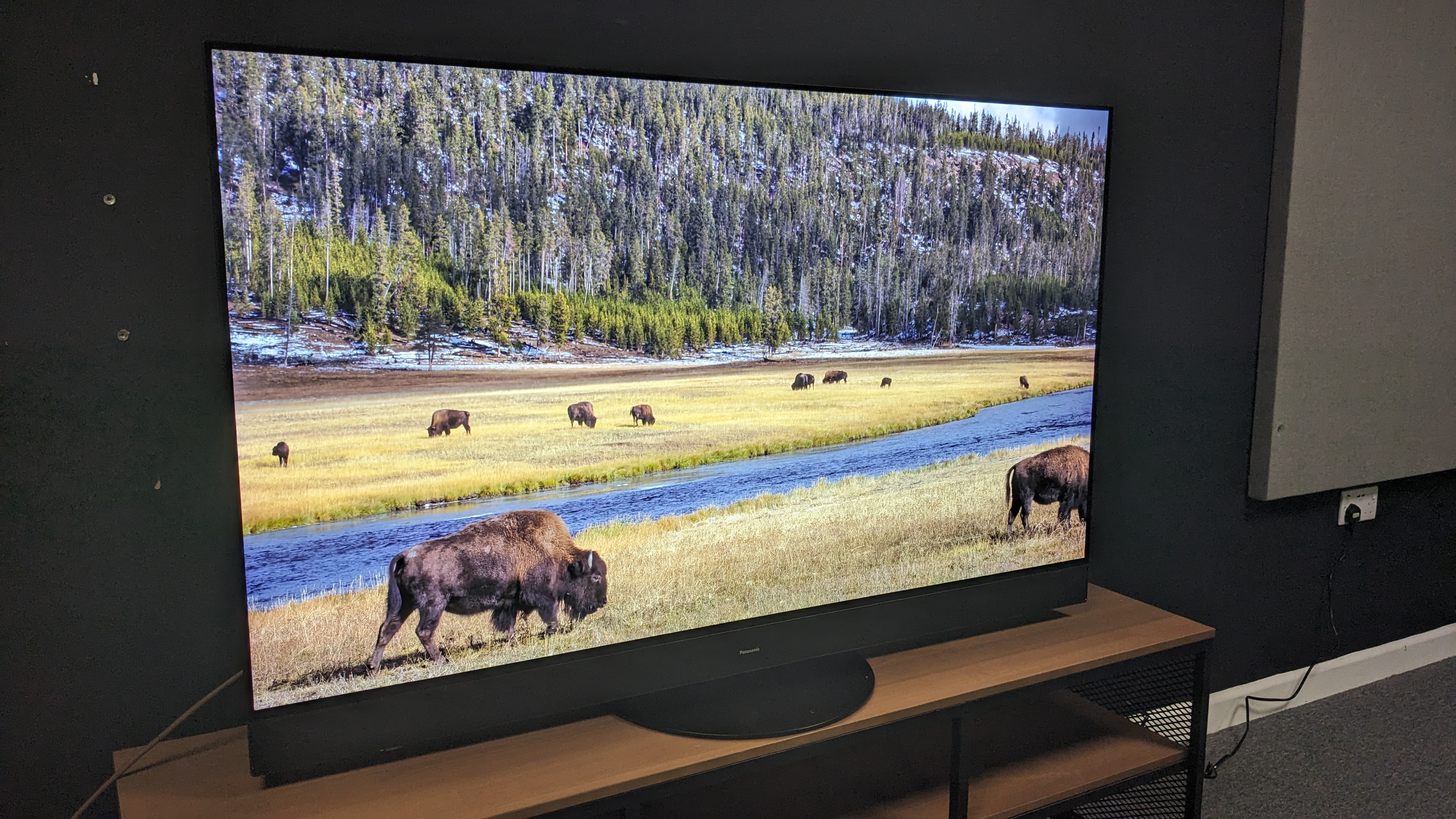
Panasonic MZ1500 review: Two minute review
The Panasonic MZ1500 is the upper-mid-range OLED TV in the company’s 2023 lineup, sitting only behind the flagship Panasonic MZ2000. It’s available in 55 and 65-inch sizes, and offers plenty of features and performance for its price. Speaking of price, the MZ1500 has seen price drops since its release in October 2023, with the 55-inch size we tested selling for £1,599 at the time of writing, to put it at a similar price point to its rivals.
Picture quality is the highlight of the MZ1500, with stunning colours, deep black levels, spectacular contrast and natural, detailed textures all combining to create an outstanding picture. It features an OLED EX panel with heat-sink technology and is brighter than the likes of rival OLEDs such as the LG C3 and Sony A80L, but a lack of micro-lens-array (MLA) tech means it’s not as vibrant as TVs like the LG G3 or Panasonic MZ2000 that feature MLA. Make no mistake though – the MZ1500’s picture is up there with the best TVs on the market.
Thanks to a comprehensive built-in speaker system, the MZ1500 has powerful, immersive sound that tops most other OLED TVs on the market. Speech is crystal clear, bass is punchy and there’s a great balance between mids and trebles though Dolby Atmos isn’t quite as pronounced as expected. Those looking for the complete experience may want to consider one of the best soundbars, but for those not wanting an external sound system, the MZ1500’s built-in sound shouldn’t disappoint.
The MZ1500 comes packed with plenty of gaming features, including 4K 120Hz support, VRR, ALLM, AMD Freesync Premium and Nvidia G-Sync to name a few. It also supports Dolby Vision gaming at 4K 60Hz. Performance-wise and graphically, the MZ1500 is impressive and although it may not be the best gaming TV on the market (that title goes to the Samsung S90C for 2023) it’s still a great gaming option.
In terms of design, the MZ1500 is sleek, attractive and solidly built. Its included stand feels reassuringly expensive and weighty and swivels for easy placement. However, the included remote still feels outdated and cumbersome compared to remotes supplied with other OLEDs from Samsung, LG and Sony.
For its smart TV platform, the MZ1500 uses Panasonic’s own my Home Screen8.0. Whilst offering plenty of settings and options to tweak for picture and sound, my Home Screen8.0 still feels awkward to navigate compared to other smart TV platforms and a little clunky in places. Some may prefer its simplified approach, but others may be overwhelmed by the sheer number of settings you can explore.
Overall, the Panasonic MZ1500 is an outstanding TV for movies, with its superb picture quality and powerful built-in sound. It also provides a great option for gaming with extensive features and good performance. Its smart TV platform may not suit everyone and it is a little pricier than other OLEDs on the market, but with that in mind, the MZ1500 is amongst one of the best OLED TVs you can buy.
For this review, I tested the 55-inch version of the Panasonic MZ1500.
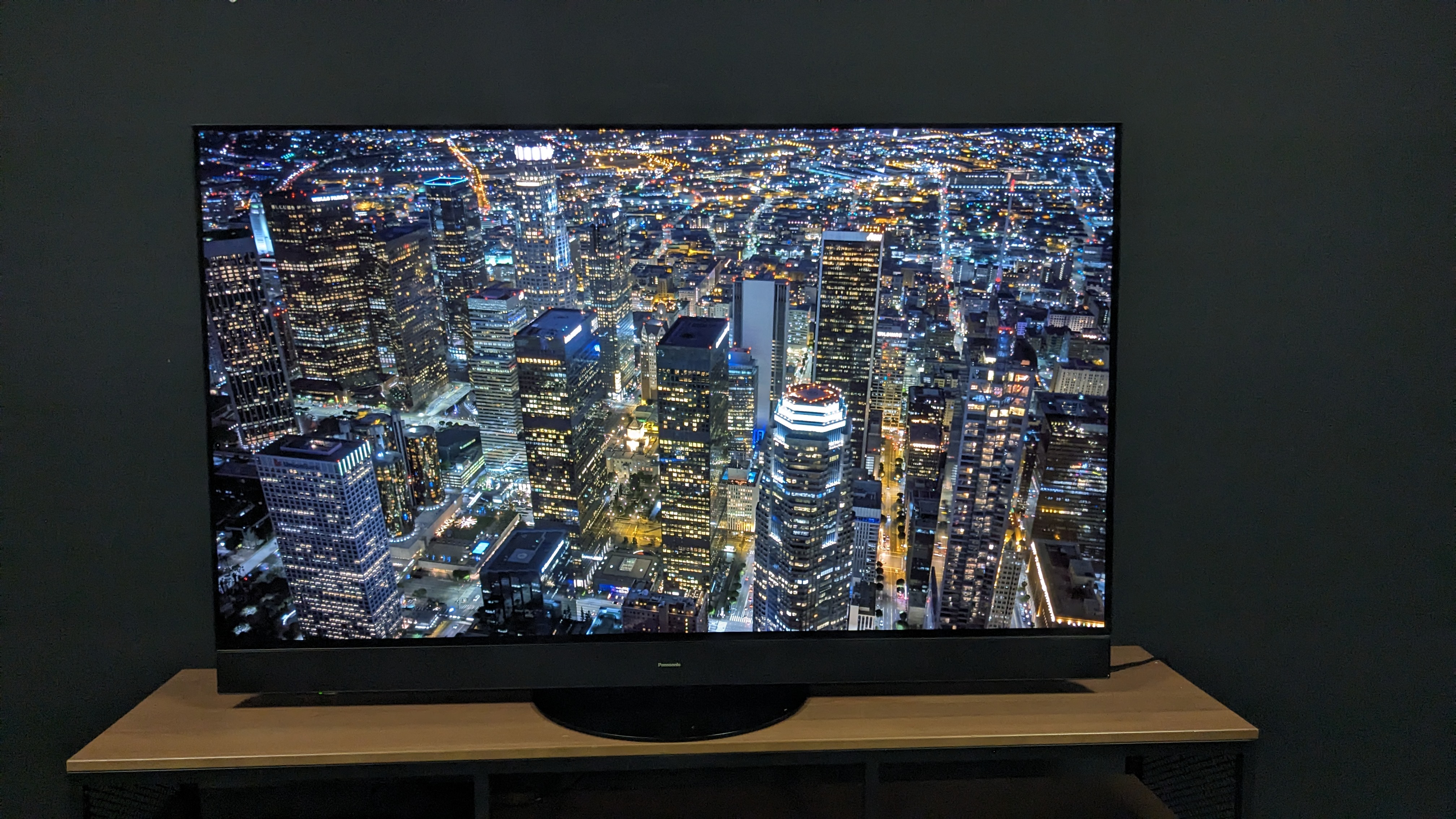
Panasonic MZ1500 review: prices & release date
- October 2023
- 55-inch: £1,899
- 65-inch: £2,499
Released in October 2023, the Panasonic MZ1500 is the upper-mid-range OLED TV in the company’s 2023 lineup, behind the flagship MZ2000. When released in October 2023, the 55-inch model was priced at £1,899 and the 65-inch model at £2,499. For the specs it has, this was higher than a lot of rival OLED sets such as the Samsung S90C and LG C3.
At the time of writing, several weeks after release, prices for the MZ1500 have dropped, with the 55-inch model now priced at £1,599 and the 65-inch model at £1,999. This puts it in roughly the same price bracket as the Sony A80L and Samsung S95C.
Panasonic MZ1500 review: Specs
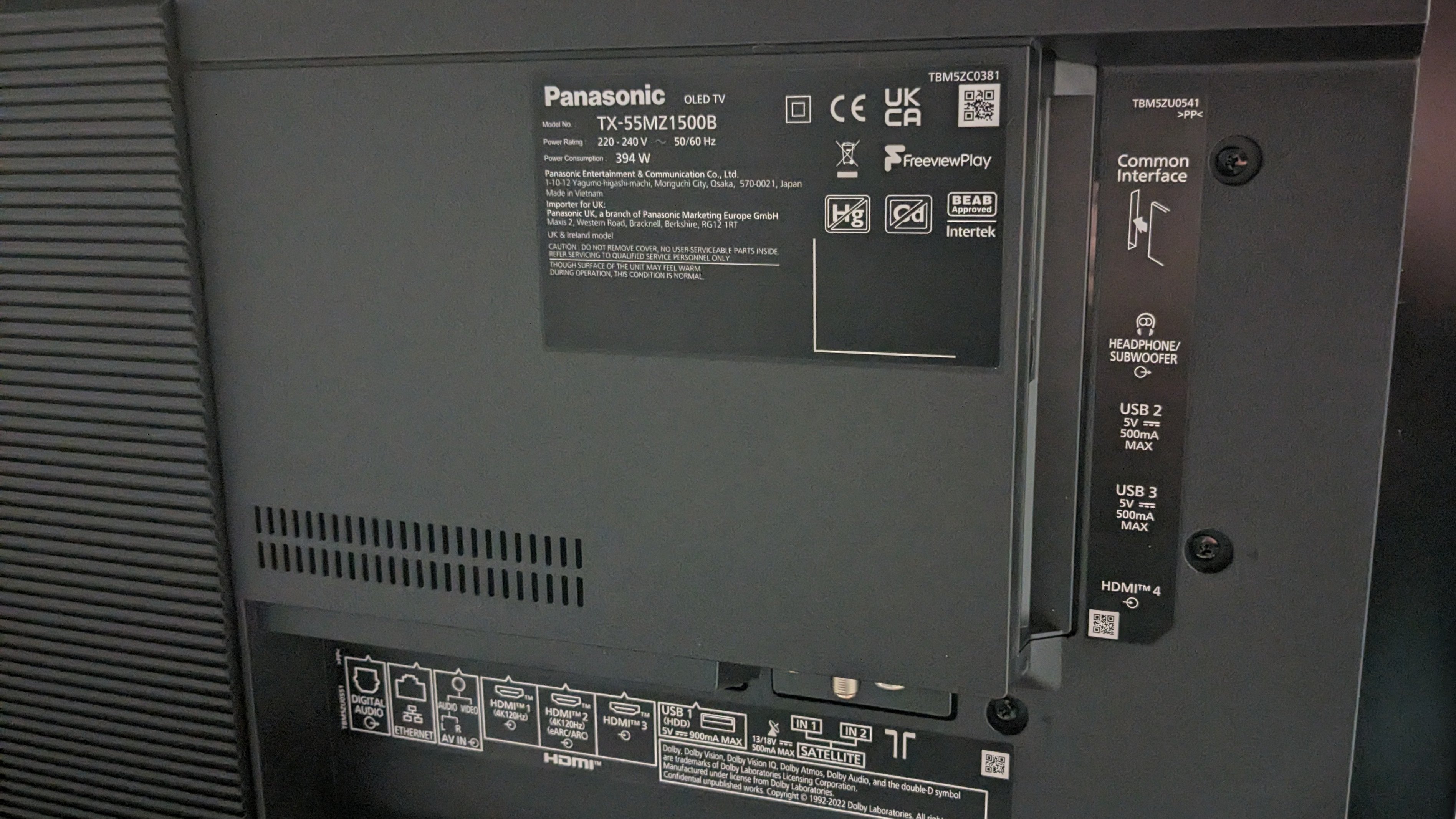
Panasonic MZ1500 review: Features
- Dolby Vision and HDR10+ support
- OLED EX panel with heat-sink technology
- 2.1-channel speaker system
The Panasonic MZ1500 comes equipped with an OLED EX panel, the same type you’ll find in the LG C3, and heat-sink technology. Combined, these aim to boost the overall brightness of the MZ1500 over a standard W-OLED panel. However, the MZ1500 does not feature the MLA technology that is featured in Panasonic’s flagship OLED, the MZ2000. The MZ1500 comes in two sizes: 55 and 65-inch.
In terms of HDR, the Panasonic MZ1500 supports both Dolby Vision (standard and IQ) and HDR10+ (standard and adaptive). This makes it one of the few OLED TVs that supports all the HDR formats you could need. It also comes with the HXC Pro AI Processor, the same processor found in the flagship MZ2000.
The MZ1500 has an extensive array of gaming features, including 4K 120Hz support, VRR, ALLM, AMD FreeSync Premium and Nvidia G-Sync compatibility. It also supports Dolby Vision gaming, though only at 4K 60Hz. Frustratingly, there are only two HDMI 2.1 ports, one of which is for eARC, whereas TVs such as the LG C3 and Samsung S90C come equipped with four HDMI 2.1 ports. There’s also a Game Mode to optimise settings for gaming and a dark visibility enhancer to brighten the picture.
As for sound, the Panasonic MZ1500, much like the MZ2000, features a more stocked speaker system than the average TV. It's a 2.1-channel system, consisting of an external soundbar for the front channels and a subwoofer totalling 50W of power. The MZ1500 supports Dolby Atmos, but not DTS:X.
Using my Home Screen 8.0 as its smart TV platform, the Panasonic MZ1500 has access to all the apps you expect such as Netflix, Disney+ and Prime Video, but also supports UK Freeview apps like BBC iPlayer, ITVX and more. It offers plenty of settings to tweak for picture and sound to tailor your movies and TV shows to what you want.
- Features score: 4.5/5
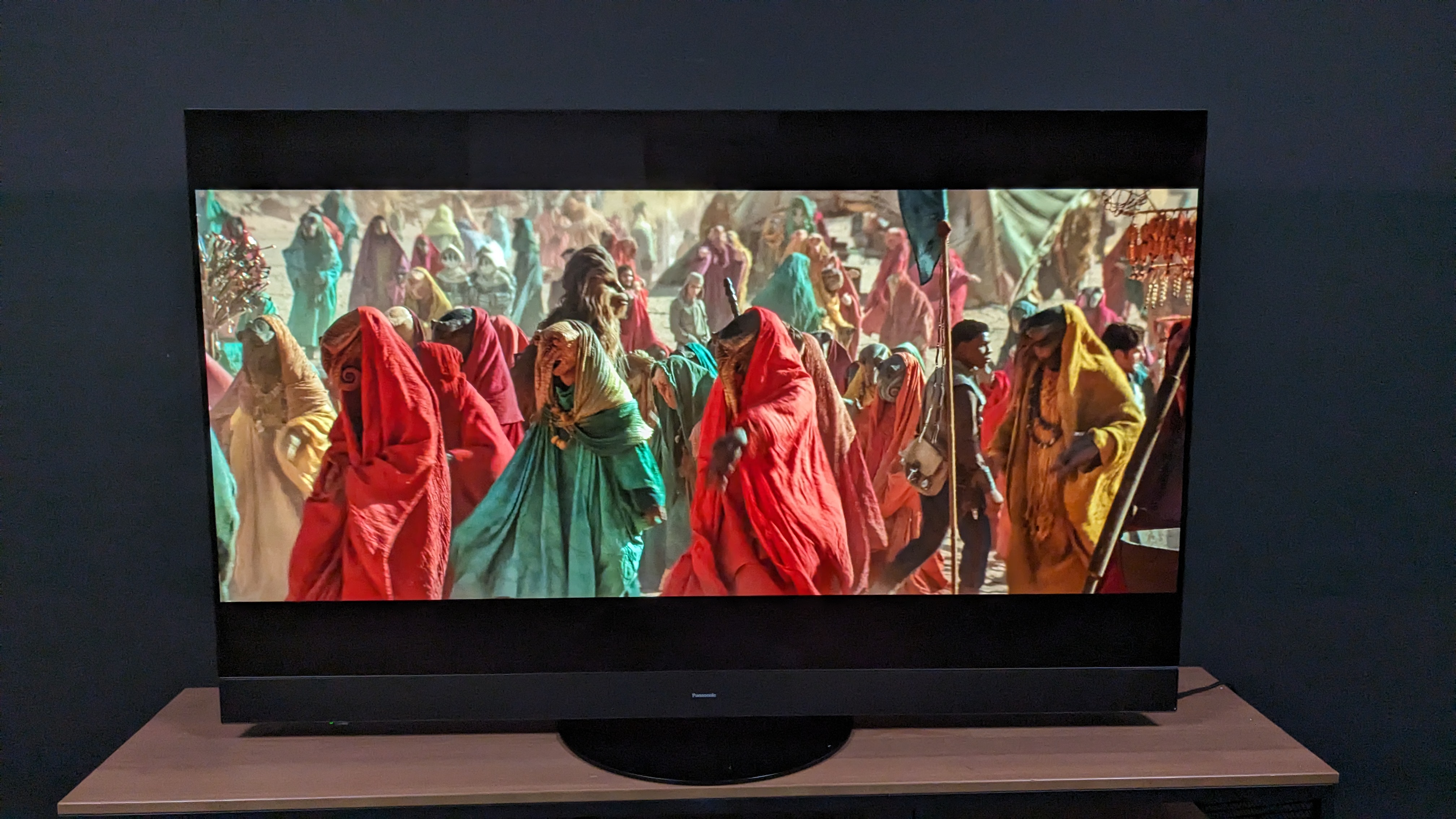
Panasonic MZ1500 review: Picture quality
- Phenomenal black levels and contrast
- Dynamic colours
- Beautifully defined sharpness and textures
With an OLED EX panel, the same that can be found in the LG C3 and Philips OLED808, and heat-sink technology, the MZ1500 aims for a brighter picture than many of its rival mid-range OLEDs on the market and, in terms of peak brightness, it succeeds.
When measuring peak brightness with Portrait Displays’ Calman software, the MZ1500 yielded a result of 1,000 nits in Filmmaker mode and 811 nits in Standard picture mode. That beats the likes of the LG C3 and Sony A80L, but it doesn’t hit the 1,480 and 1,449 nits peak brightness heights we measured on the more premium Panasonic MZ2000 and LG G3, respectively. This is due to the lack of micro-lens-array (MLA) technology in the MZ1500 compared to those two more flagship TVs.
For this review, I used the 55-inch model of the MZ1500. I started by cycling through the TV’s preset picture modes to determine the best ones and, unsurprisingly, Filmmaker mode came out on top. As Dolby Vision is not compatible with Filmmaker mode, the MZ1500 would switch to Dolby Vision IQ for any movies or shows with Dolby Vision HDR. Standard and Movie were also strong picture preset modes, but Filmmaker remained the best.
Firstly, I watched SDR live TV shows via antenna to see how the MZ1500 could handle lower-resolution and HD signals. The MZ1500’s upscaling was effective, with skin tones and textures still maintaining a true-to-life look that I’ve come to expect from Panasonic OLEDs. Watching some Formula 1 highlights in low-resolution, the image was a little fuzzy, but colours were still striking and the motion of the cars gliding around the track was well-handled even in Filmmaker mode with no motion processing aids turned on.
I next moved on to 4K HDR sources starting with demo footage from the Spears & Munsil UHD Benchmark 4K Blu-ray. Cycling through images of nature, landscapes, a city and night and detailed studio-shot footage, the MZ1500 showcased its punchy colours, rich contrast and gloriously deep black levels. A shot of a bright ferris wheel against a jet-black sky showed just how stunning the MZ1500’s contrast was. Once again though, sharpness and textures were the real highlight of the MZ1500, with animals and intricate details seeming to jump from the screen.
For another test of the MZ1500’s black levels and shadows, I moved on to The Batman. In the subway scene early in the film, black tones and shadows were excellent, conveying the brooding, moody tone perfectly. Contrast was another highlight as scenes where lights were sparingly used to balance the deep shadowed areas, such as the one in the subway, illuminated surrounding objects and characters without impacting the luscious dark tones. When measuring the grayscale of the MZ1500 and recording its Delta-E values (the margin of error between a test pattern and what’s shown on screen) I was unsurprised to see it yield a great result of 1.9 (we typically look for a score below 3).
Next, it was time to test colour and Dolby Vision. I first opted for several different scenes from Star Wars: Rise of Skywalker. In the festival scene, colours were bright, vivid and dynamic, as the mix of greens, yellows and oranges exploded on screen. Next, viewing several scenes with lightsabers, although the colour was still impressive and vibrant, I couldn’t help but notice it didn’t have the same punch as the Panasonic MZ2000 and LG G3, which indicated the MZ1500 was missing the MLA tech needed to give it that extra bite. Still though, the colours were beautiful and maintained a natural, detailed look.
Using a scene from Godzilla vs Kong where Godzilla invades Tokyo, I was still impressed with how fantastic the colours were as neon signs jumped from the screen in a brilliant and still bright mix of colours. It’s again unsurprising the MZ1500’s colours are so vibrant as when I measured the DCI-P3 (the colour space used to master 4K Blu-ray and digital cinema releases) and BT.2020 colour gamut coverage, the MZ1500 yielded 99.5% and 75.4%, respectively (in Filmmaker mode), which are phenomenal results.
Finally, using Top Gun: Maverick to test motion handling, the MZ1500 effortlessly processed the jets as they tore across the screen. Motion was fluid and fast-paced. Digging into the settings, I noticed that even in Filmmaker Mode, the MZ1500 added in minimal Intelligent Frame Creation (IFC) to reduce blur and judder. I turned this off and, thankfully, motion was still smooth.
- Picture quality score: 5/5
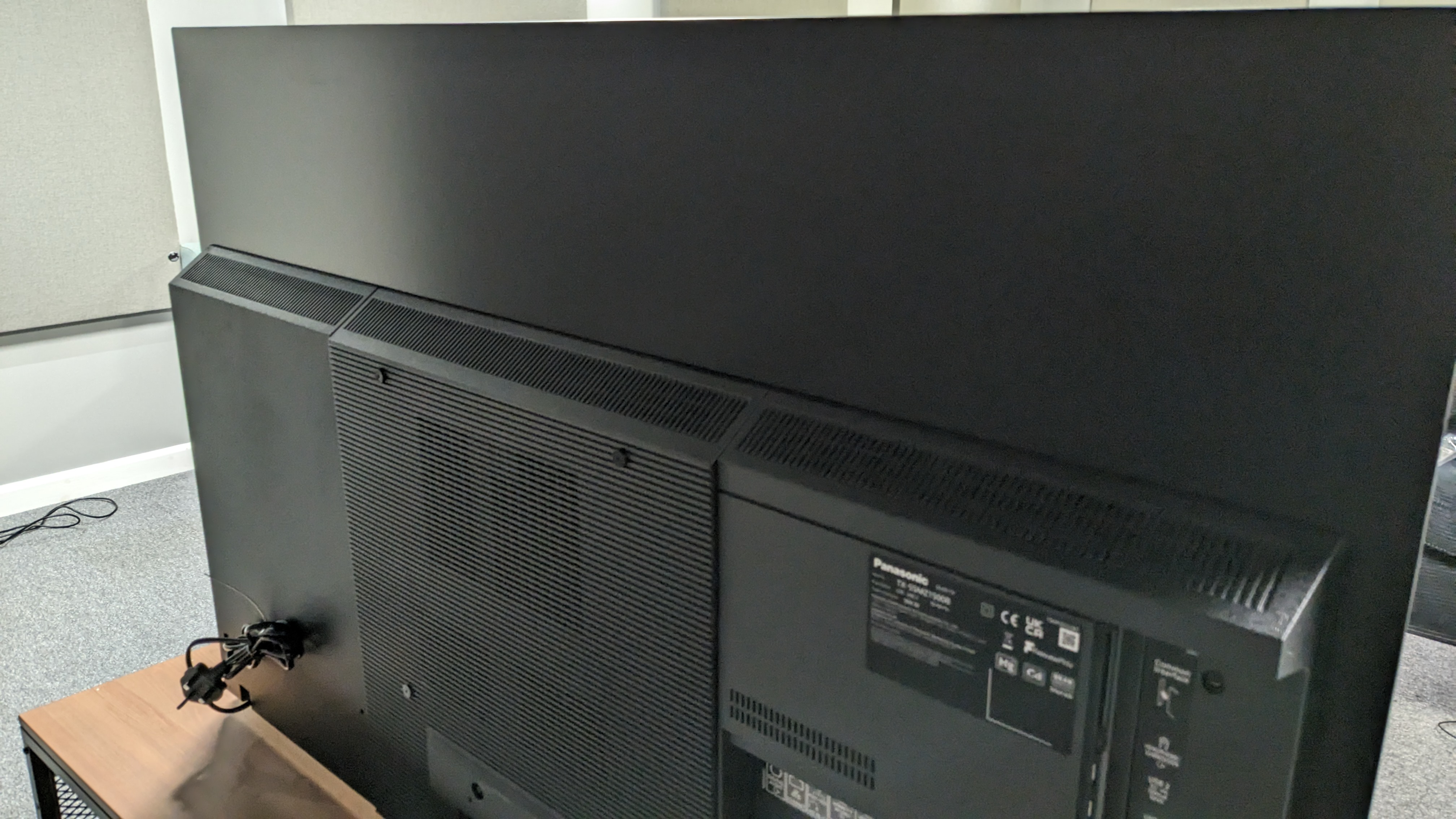
Panasonic MZ1500 review: sound quality
- Dolby Atmos support
- External soundbar as front speakers
- 2.1-channel configuration
Panasonic has always aimed to give some of the best built-in TV sound on the market and for the most part, it’s a top contender in this category. Whilst the Panasonic MZ1500’s sound is certainly still impressive, it doesn’t hit the same levels as other OLEDs such as the Panasonic MZ2000 or the Sony A80L.
Featuring a similar external soundbar and subwoofer as the MZ2000, the MZ1500 still delivers a meaty, immersive sound that will suit people who don’t want to use an external soundbar. For sound settings you can choose a preset sound mode and a ‘sound creation’ profile to tailor the sound to your liking. I found Standard mode with Theater sound creation to be the best across various TV shows and movies.
Watching the Batmobile chase from The Batman, the rumbling bass of the engine felt weighty through the MZ1500’s speakers. The MZ1500 also created a nice, wide soundstage creating an immersive atmosphere and the speakers did a great job of following the action on screen as cars swivelled throughout traffic during the chase. Although the overall balance of sound was excellent at higher volumes, with dialogue nice and clear, the bass did start to overpower in the mix. But this can be easily corrected through the MZ1500’s settings.
In Top Gun: Maverick, the sound was again dynamic, powerful and well-balanced. In terms of Dolby Atmos, the MZ1500 did create an immersive atmosphere, but it didn’t feel as all-encompassing as I expected. It’s worth noting that when viewing Dolby Atmos scenes in the tests, I noticed that the sound mode was locked in the ‘direct through’ sound creation mode, which didn’t seem to have the same balance as the Theater mode mentioned above.
One other omission compared to the MZ2000 is the lack of the Space Tune setting, which uses room calibration to get the best from the speakers. This added a whole other layer to the MZ200’s sound when I tested that TV and would have been a nice inclusion on the MZ1500, but still the MZ1500 delivers in terms of built-in sound quality. If you’re looking for the complete experience however, you’ll probably want to look at getting one of the best Dolby Atmos soundbars to compliment the MZ1500’s picture.
- Sound quality score: 4.5/5

Panasonic MZ1500 review: Design
- Simple but effective metal stand
- Slim bezel
- Supplied remote feels dated
The Panasonic MZ1500 looks strikingly similar to the MZ2000, and that’s not a bad thing. The MZ1500 has an identical stand (we tested the 55-inch size of both models) which is a circular, black metal base that feels solid and weighty. It also has the ability to swivel, meaning that placement of the MZ1500 within a room is flexible.
The TV itself has a slim bezel and sleek trim, giving more space for the fantastic picture on the screen. It’s a little deeper than other TVs, but this is to be expected as it’s accommodating the more extensive speaker system. It’s not as attractive as TVs such as the gorgeous Samsung S90C and S95C or even the LG G3, but it’s still a sturdy, solid set.
One downside, and it’s the same one as with the MZ2000, is the supplied remote control. Although it comes with many buttons which some people may find useful, the design itself feels dated, and that impression isn’t helped by its large size. Compared to remotes with TVs from Samsung, LG, Sony and others, the Panasonic’s remote doesn’t feel like a remote supplied with a premium TV.
- Design score: 4/5
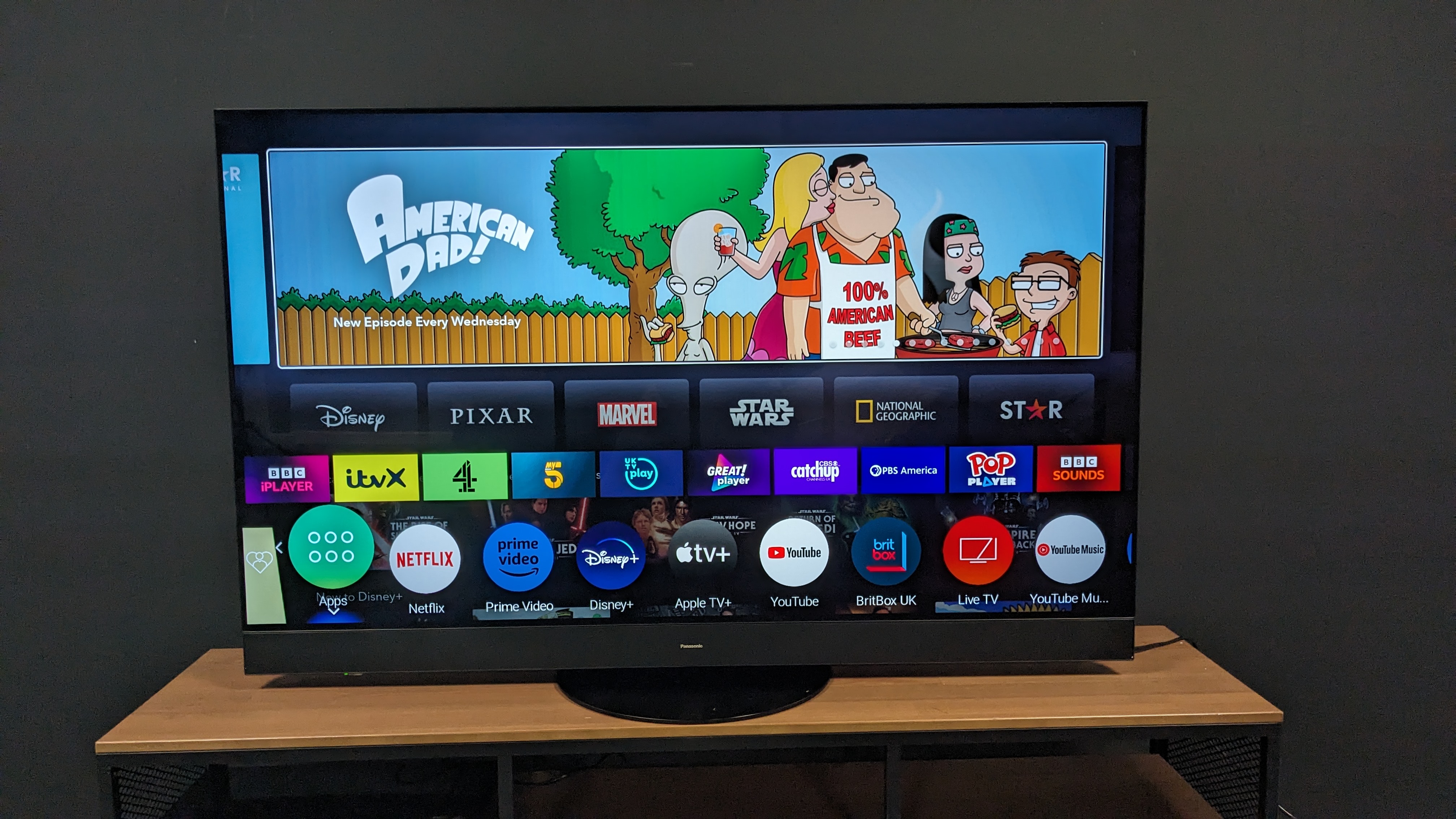
Panasonic MZ1500 review: Smart TV & menus
- Plenty of settings to tweak for picture and sound
- Easy-to-read format
- Can be clunky to navigate
Much like the Panasonic MZ2000, the MZ1500 comes with the my Home Screen8.0 smart TV platform. Panasonic has favoured simplicity over anything else in terms of a home page, with a simple bar that pops up with all the major apps appearing when you press the home button on the remote. There is an apps page that feels more like a home screen for those who want it.
The my Home Screen8.0 interface also features a ‘my scenery’ mode that’s similar to the Ambient modes on Samsung and Amazon Fire TVs where an image (static or dynamic) can be displayed with background music. Some of the backgrounds even support Dolby Atmos backing music and you can even add your own images via USB.
During my review of the MZ2000, I found my Home Screen8.0 to be clunky and awkward to navigate and although this is still the case, it did feel slightly smoother on the MZ1500. Menu navigation is not overly easy in comparison to other smart TV platforms such as LG’s webOS and Samsung’s Tizen. However, one welcome aspect is that there are minimal ads and recommendations, which on other smart TV platforms can feel too much.
One real positive is the amount of settings that can be adjusted and tweaked within the settings menu. The my Home Screen8.0 interface offers plenty of ways you can tailor the picture and sound to suit your needs and although some may find the sheer amount of options overwhelming, no other TV comes close. Speaking of menus, my Home Screen8.0’s menus have a dated appearance.
- Smart TV & menus score: 3.5/5
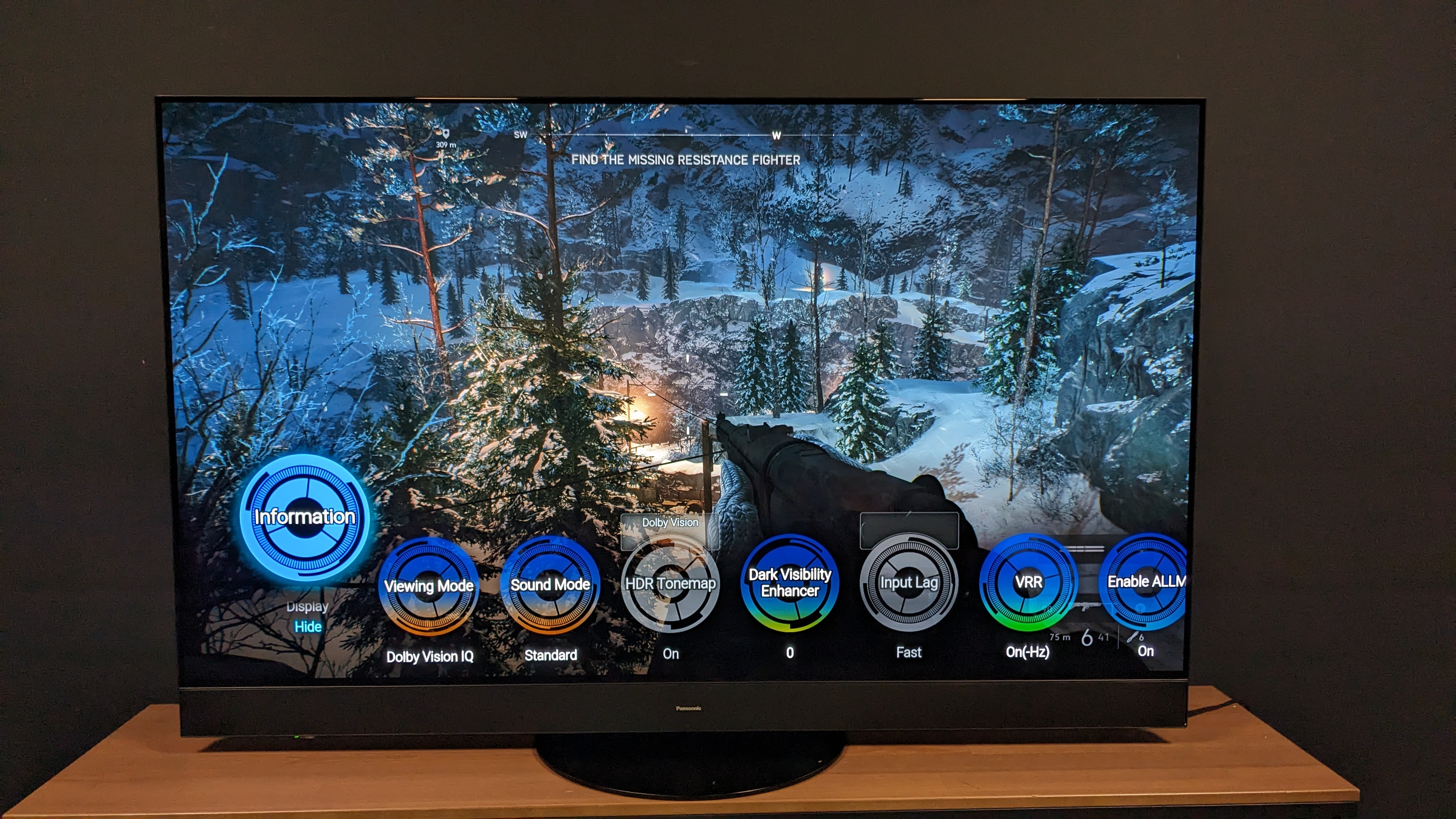
Panasonic MZ1500 review: Gaming
- Extensive gaming features
- Game Bar included
- Only two HDMI 2.1 ports
The Panasonic MZ1500 has an extensive list of gaming features, including 4K 120Hz support, VRR, ALLM, AMD FreeSync Premium, Nvidia G-Sync compatibility and Dolby Vision gaming (although only at 4K 60Hz). It also comes with a Game mode and Game Bar to optimize settings for video games.
In terms of gaming performance, the MZ1500 is an excellent gaming TV. When playing Battlefield V, motion handling is incredibly smooth at 120Hz, with quick switching between targets and scanning across landscapes feeling as fluid as you could hope. When playing in Dolby Vision mode at 60Hz, Battlefield V still felt free-flowing and fast-paced even at the slower frame rates. Using the Leo Bodnar 4K HDMI input lag tester, I measured the input lag at 14.3ms at 4K 60Hz, which is a respectable result that puts it above the Sony A80L, but not quite at the same level as TVs such as the LG C3 or Samsung S90C, which both measured at under 10ms.
Graphically, the MZ1500 is as impressive for video games as it is for movies. Playing a stealth mission set at night in snowy mountains in Battlefield V, the black levels of the night sky were deep and accurate and the contrast brought out the dazzling white tones of the snow. One again, the sharpness and detail within the surrounding environment and textures on clothing and weapons was superb.
The MZ1500 also comes with a game bar that can be pinned to the my app menu for quick access. This allows changes to picture and sound mode and allows other settings like dark visibility enhancer to be tweaked, which brightens the environment for an edge in dark situations. It’s worth noting turning this feature up did affect the black levels of the picture. Despite its excellent gaming features and performance, the MZ1500 frustratingly is stocked with only two HDMI 2.1 ports as opposed to the four four on OLEDs from LG and Samsung.
- Gaming score: 4.5/5
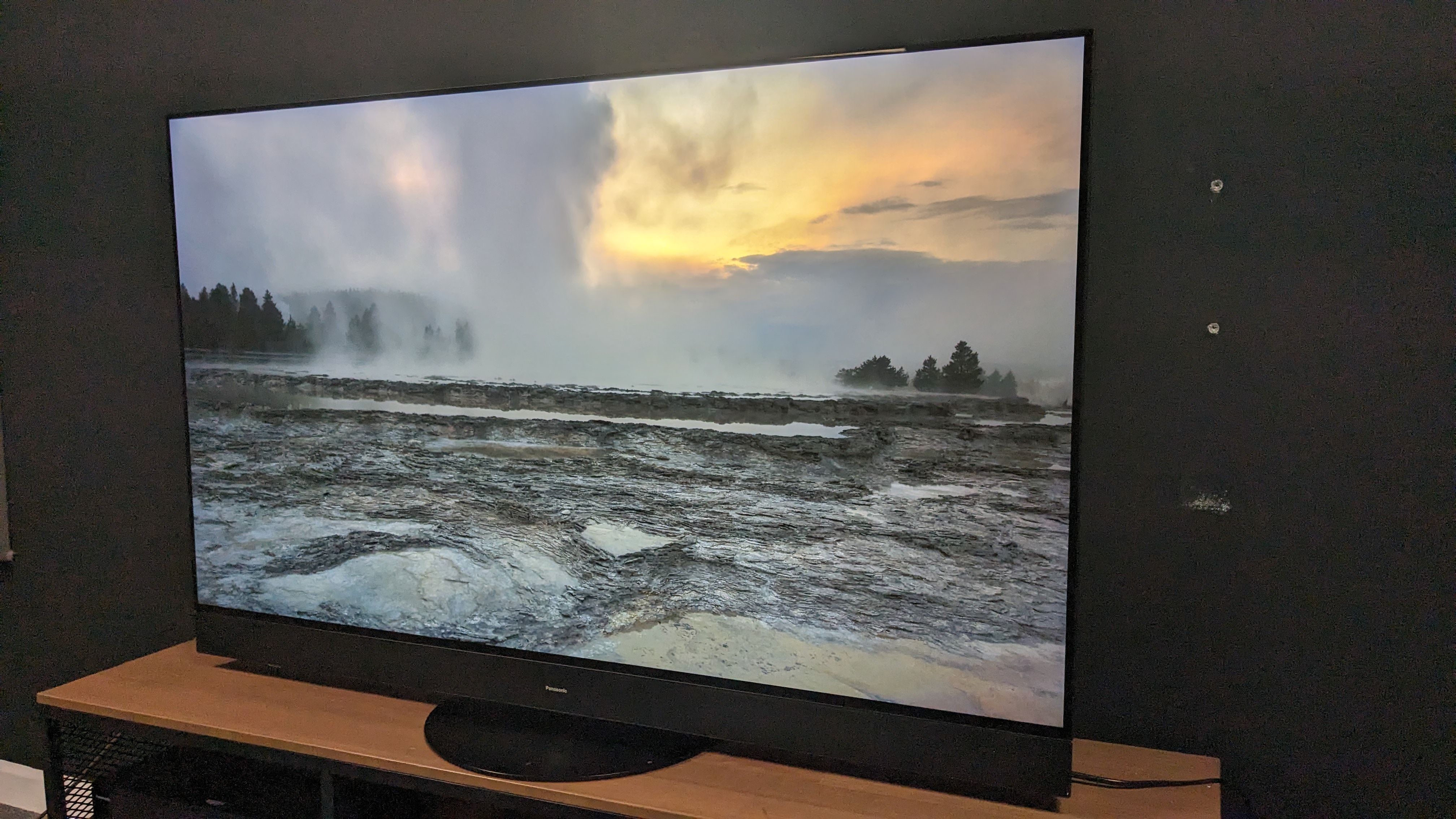
Panasonic MZ1500 review: Value
- Slightly pricier than rival OLEDs
- Great picture and performance for the price
- More premium price of the mid-range OLED market
The Panasonic MZ1500 was initially much pricier at the time of its release in October 2023 than rival OLEDs, with prices averaging over £500 more than the LG C3 and Samsung S90C. Thankfully, prices have since dropped, although the MZ1500 is still on average £100 more at most retailers, as the 55-inch is priced at £1,599 compared to the £1,299-£1,499 of the same-size LG and Samsung OLEDs.
The MZ1500 does have the added benefit of superior built-in sound compared to its rivals, but is lacking the high peak brightness of the Samsung S90C and the gaming performance and features of the LG C3. The Philips OLED808 has the fantastic Ambilight technology for extra immersion, but this is a unique feature for Philips.
Overall, the Panasonic MZ1500 offers similar features and specs to its rivals at a similar price so it sits in line with these models in terms of value. Although it’s not quite as good value as the Samsung S90C, anyone who opts for the Panasonic MZ1500 won’t be disappointed.
- Value score: 4/5
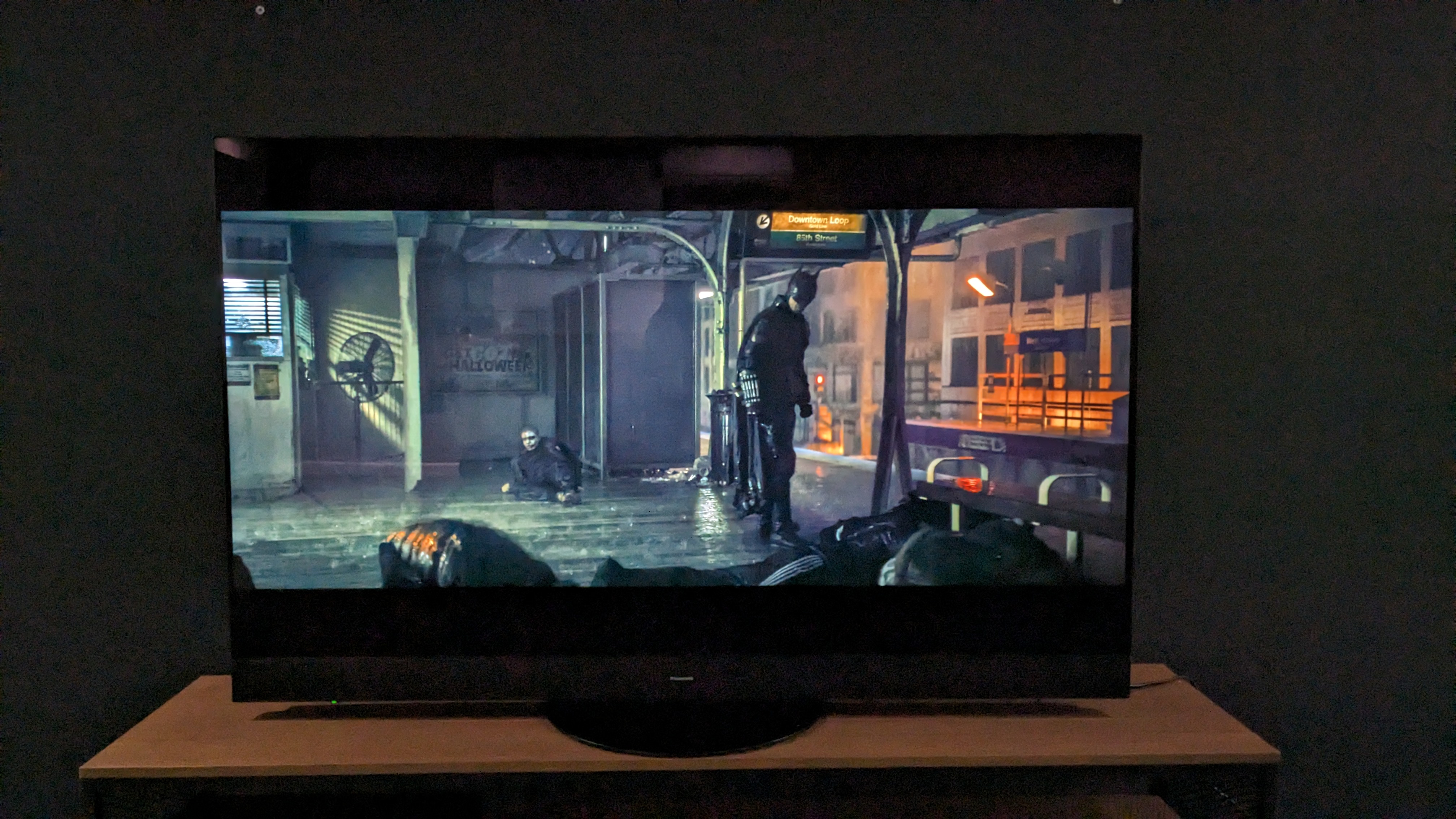
Should I buy the Panasonic MZ1500?
Buy it if...
Don't buy it if...
Panasonic MZ1500 review: Also consider
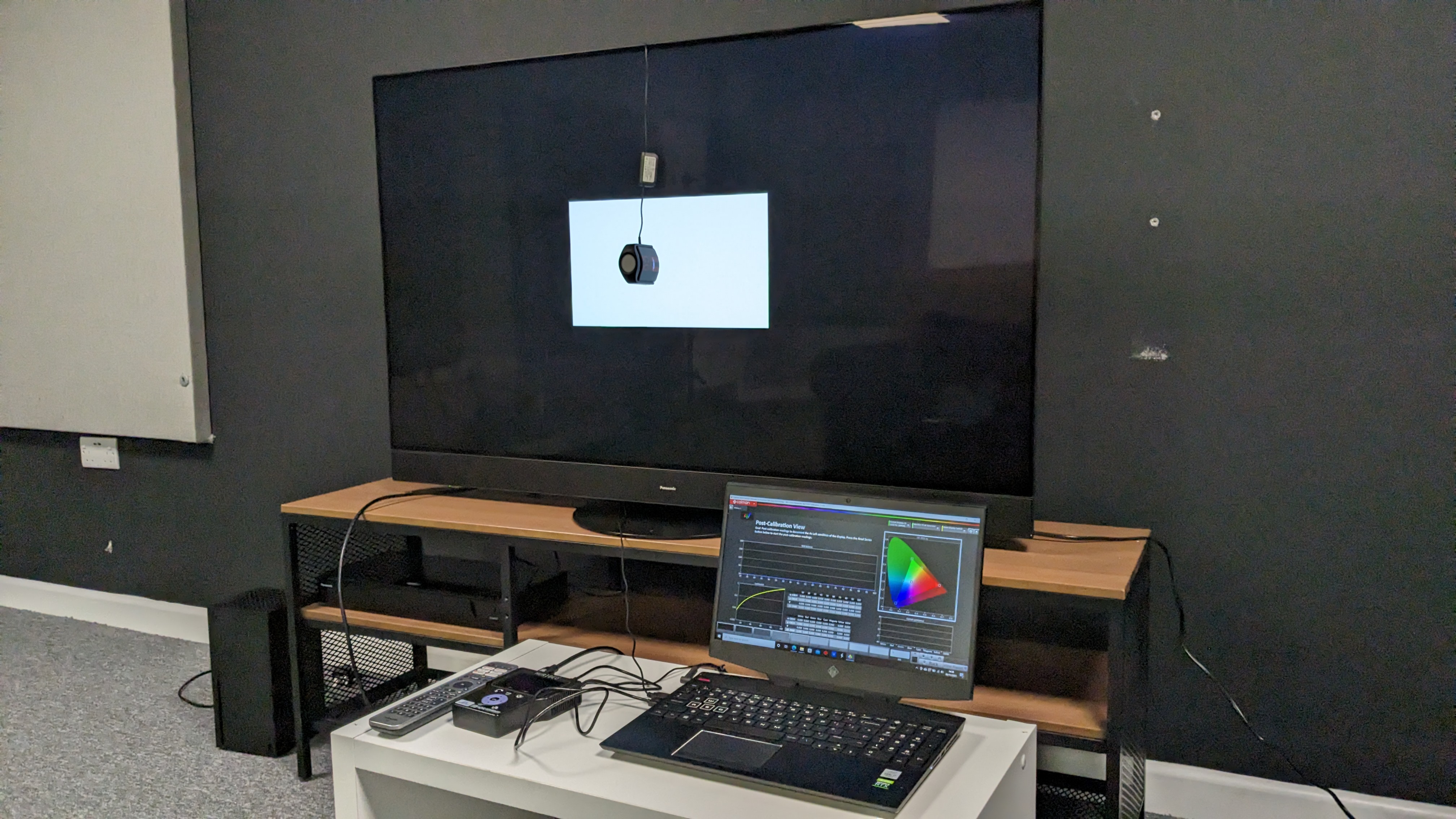
How I tested the Panasonic MZ1500
- Tested in our lab room with varying lighting conditions
- Measurements taken using Portrait Displays' Calman software
- Tested through a variety of sources, both SDR and HDR
After running in the TV for a couple of days, displaying SDR content from live TV, I tested various picture modes on the Panasonic MZ1500 including Standard and Filmmaker mode. I used a variety of SDR and HDR sources from 4K Blu-rays to streaming with both an Panasonic DPUB820 UHD Blu-ray player and a Xbox Series X console.
After choosing the best picture mode, Filmmaker, I tested the Panasonic MZ1500's picture thoroughly using Disney Plus and 4K Blu-rays for 4K Dolby Vision and HDR content, the Xbox Series X for gaming and I also used live TV antenna to test SDR.
When it came time to take measurements of the Panasonic MZ1500, I used Portrait Displays’ Calman calibration software. I first measured peak brightness on a 10% window and 100% window in both SDR and HDR. I then recorded the Delta-E values (which demonstrates the margin of error between the test pattern and what is displayed) for color accuracy, grayscale and gamma again using Calman. I then measured the color space looking at DCI-P3 and BT.2020 coverage. For all tests, I used the Murideo Seven 8K test pattern generator.
Finally, to measure input lag for gaming, I used the Leo Bodnar 4K input lag tester.
- First reviewed: December 2023
- Read TechRadar's review guarantee







